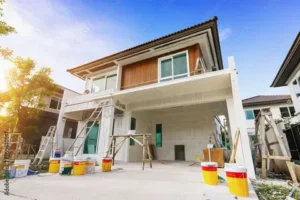Organizing a Home Enhancement Renovation Project Well
Altering one’s house may be both exhilarating and challenging. Whether you are doing a full home renovation, installing a fresh bathroom, or remodeling your kitchen, thoughtful preparation is absolutely vital for a peaceful rather than an anxiety-ridden renovation experience. Apart from saving you money and time, a well-designed project guarantees that your desired design becomes a reality devoid of any pointless complexity.
Budgeting techniques, time management, choosing the most qualified contractors, and several other considerations are all covered in this manual as steps for correct house repair project planning. You will have a clear plan for reaching your renovation objectives by the end.

Careful planning is key to organizing your home renovation project with detailed layouts, material samples, and a realistic timeline.
Planning is required for a project’s success, renovation
Beginning a renovation without adequate planning is like going on a road trip without a map; you risk getting lost and accumulating extra expenses. Becoming irritated with spending money. Good planning lets you:
Steer clear of expensive blunders.
Maintain your spending limits.
Complete the project on target.
Acquire the appearance and usefulness you want.
Minimize uncertainty and anxiety.
View the planning stage as your guard against success.
Step 1: Define a vision and objectives for renovation
You need to first clearly define your goals before you even start to consider wall destruction or color choices. Consider the next questions:
After your reconstruction, what follows? Is it to increase property values, give more space, or revise current designs?
Is it the living room, the bathroom, the kitchen, or the whole house that needs care?
Would you lean toward a contemporary, minimalist, rural, or traditional style of architecture?
Seek an opportunity to become inspired. Examine showrooms, periodicals on house design, or Pinterest boards. Creating a mood board lets you see your preferred result.
Pro Tip: Give reality front priority above looks. Future aggravation only results from a gorgeous kitchen that doesn’t fit your cooking approach.
Step 2: Build a sensible renovation budget.
The basis of the whole remodeling project is your budget. It shows you what is beyond your financial ability and what you can afford. Lacking a sound financial plan can cause either overspending or unfinished work.
These suggestions will guide you to handle your finances properly:
Break it by categories into materials, labor, licenses, and unforeseen costs.
Add a contingency fund: Set aside at least 10–20% more for unforeseen costs. Often found during repairs are concealed issues such as electrical faults or leaks in pipes.
Do not depend on one quote; instead, obtain many. To establish a reasonable price range, compare quotations from at least three builders.

Build a Sensible Budget: Allocate resources wisely to control costs, maximize value, and keep your project financially sustainable.
Sample Budget for a $30,000 Renovation:
Materials: $15,000
Labor costs: $10,000
Permits and costs: $2,000
$3,000 for emergencies.
Pro Tip: Renovation funds should not come from all of your savings. Save an emergency fund for life’s events.
In step 3: Research and recruit the right experts for renovation
Although an unskilled contractor can turn your concept for repair into a disaster, a good contractor may realize it. Take the time to choose the right experts:
Friends, family, or neighbors who have recently finished repairs can make a superb source of referrals.
Examine reviews and ratings: use sites like Google Reviews, Angi (previously Angie’s List), or Houzz.
Check credentials: confirm their necessary qualifications, insurance, and licenses.
Interview multiple builders; consider their experience and soft skills, as well as their least costly option.
Pro Advice: Be sure to write contracts that describe the work in detail and specify deadlines and payment schedules. Everything should be documented.
Step 4: Create a complete restoration plan for renovation
A thorough strategy ensures everyone is on the same page; it should cover the following areas:
The scope of the project comprises particular chores that have to be done.
Timeline: Include important dates, starting and finishing dates.
Among the supplies are paint colors, fittings, tile, flooring, and more.
Budget management: Use a spreadsheet or an app like CoConstruct or Buildertrend.
This helps to avoid misunderstandings and minimizes last-minute changes that might jeopardize your project.

A guided path to renewal, restoring balance, strength, and confidence with every step.
Step 5: Obtain all necessary permissions and approvals for the renovation
Many times, failing to get the required permissions leads to project delays, fines, or complications in selling your house. Regulations vary. By location, though, permits are needed for the majority of major renovations, including those for:
electric fixtures
Plumbing modifications
modifications in the form
Raises or extensions
Early submissions of your applications will help you to prevent delays; for assistance, get in touch with your local building authority.
Step 6: Organize Your Accommodation Renovation
Particularly those that have an effect on vital areas like the kitchen or bathroom, significant repairs can greatly disturb your daily routine. It is advised that you plan:
As a temporary kitchen solution, use a microwave, toaster oven, or outdoor grill.
Consider renting a short-term apartment or residing with family if the repairs are extensive.
Safety precautions: Building sites should keep kids and animals away.
In step 7: choose high-quality components.
While the need to reduce costs on materials can be strong, inexpensive goods often result in future repairs. Choose classic, long-lasting materials; for instance:
Select excellent hardwood or vinyl over cheap laminate.
Choose quartz or granite for counters for their robustness.
Select stainless steel or brass fittings, as they are more robust.
Keep in mind that employing high-quality materials elevates both the appearance and worth of your house.
Step 8: Get in touch with your contractor frequently.
Effective communication is vital if one wants to avoid errors in understanding. Set up weekly meetings to go over development, address any changes, and confirm important decisions.
Pro Tip: To register bills, receipts, and conversations, keep a project journal or use an app.
Step 9: Always be prepared for the unplanned renovation
Even the most well-designed home repair plans can become complicated by the weather, backordered materials, unexpected structural problems, and other factors. Be patient and flexible. For this reason, having a realistic schedule and a contingency budget is crucial.
Step 10: one final quality assurance examination renovation
Before finishing the final payment, do a comprehensive inspection together with your contractor:
Look for any imperfections in the finishes, paint, tile alignment, and grout lines.
Examine the plumbing and electrical networks.
Ensure that all agreed-upon work has been done.
Before making the final payment, you should report any issues found, note them, and request repairs.
Advice for a Stress-Free Remodeling Adventure
Remove all items from the area being renovated before beginning your decluttering.
Keep everything in one folder to help you remain organized.
Take breaks: Renovations might be a lot; take a step back when you need to.

Final Quality Assurance: A thorough examination is performed to verify accuracy, compliance, and overall quality before the project is officially approved.
In Conclusion:
Selecting paint colors is only one part of properly organizing a home remodeling project; you also have to develop a thorough plan to ensure a frictionless process. Every stage, from establishing a reasonable budget and choosing qualified experts to obtaining necessary permits and sustaining clear channels of communication, is critical to making your perfect home one free of needless stress.
Keep in mind that your most precious assets are patience, flexibility, and thorough preparation. With well-planned home renovation ideas, you may turn your home into something absolutely stunning.
FAQs:
1. A home renovation typically lasts how long?
The length varies depending on the extent of the project. Renovating a single room could take 2–4 weeks; however, a whole home renovation could require 3–6 months.
2. What one aspect of a remodel costs the most?
Often, the most expensive rooms are those with plumbing, fixtures, and appliances.
3. How much contingency money should I reserve?
For unforeseen expenditures, you should save at least 10 to 20 percent of your whole budget and home renovation loan.
4. Do I need permission for aesthetic changes?
Generally, cosmetic changes such as painting or flooring replacement don’t call for permits; structural, plumbing, or electrical modifications usually do.
5. Should I move while major maintenance is being done?
Moving briefly might be helpful if the remodeling is extensive or impacts essential spaces like the kitchen or bathrooms in order to lower the speed and pressure and expedite the process.

